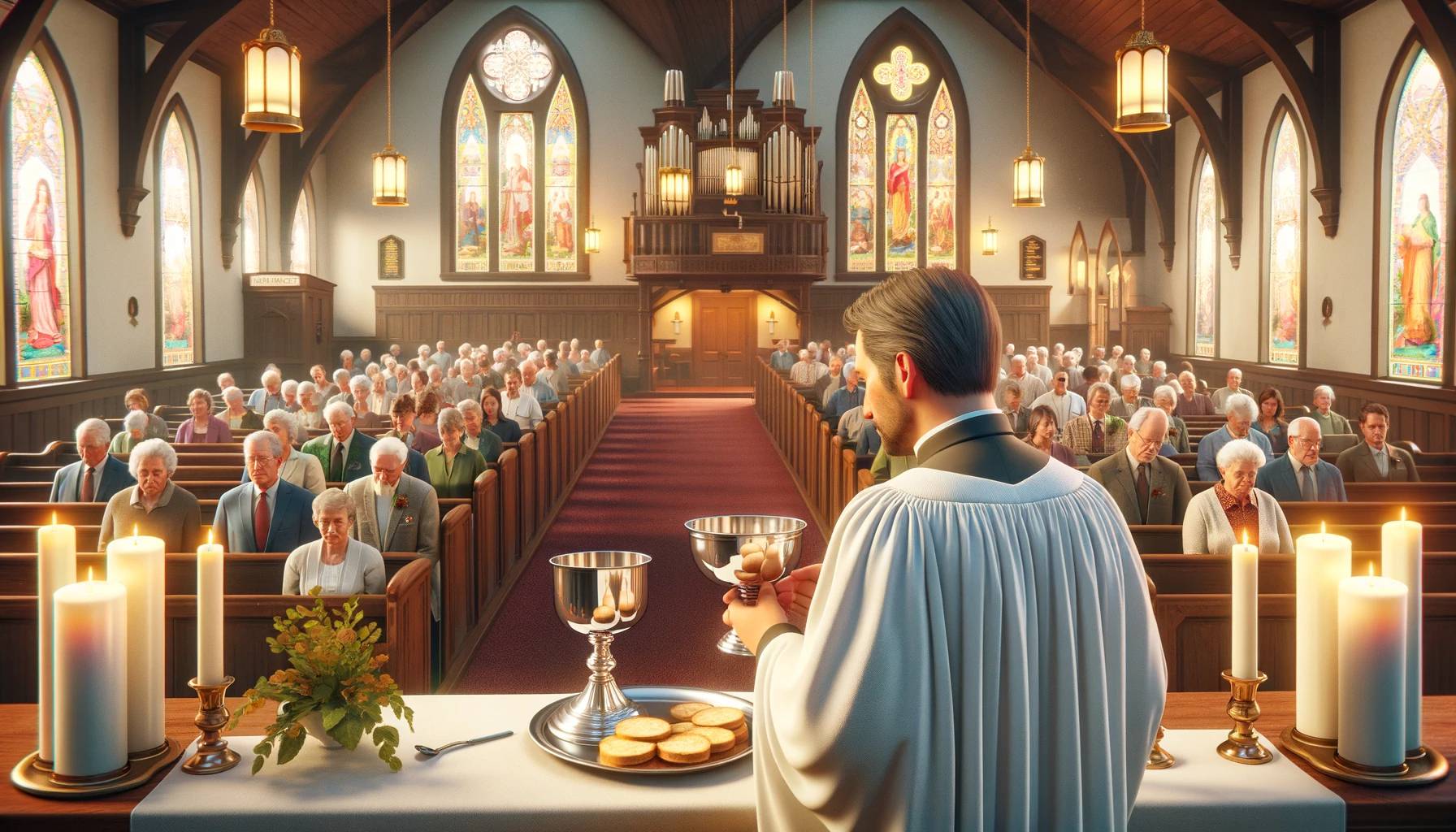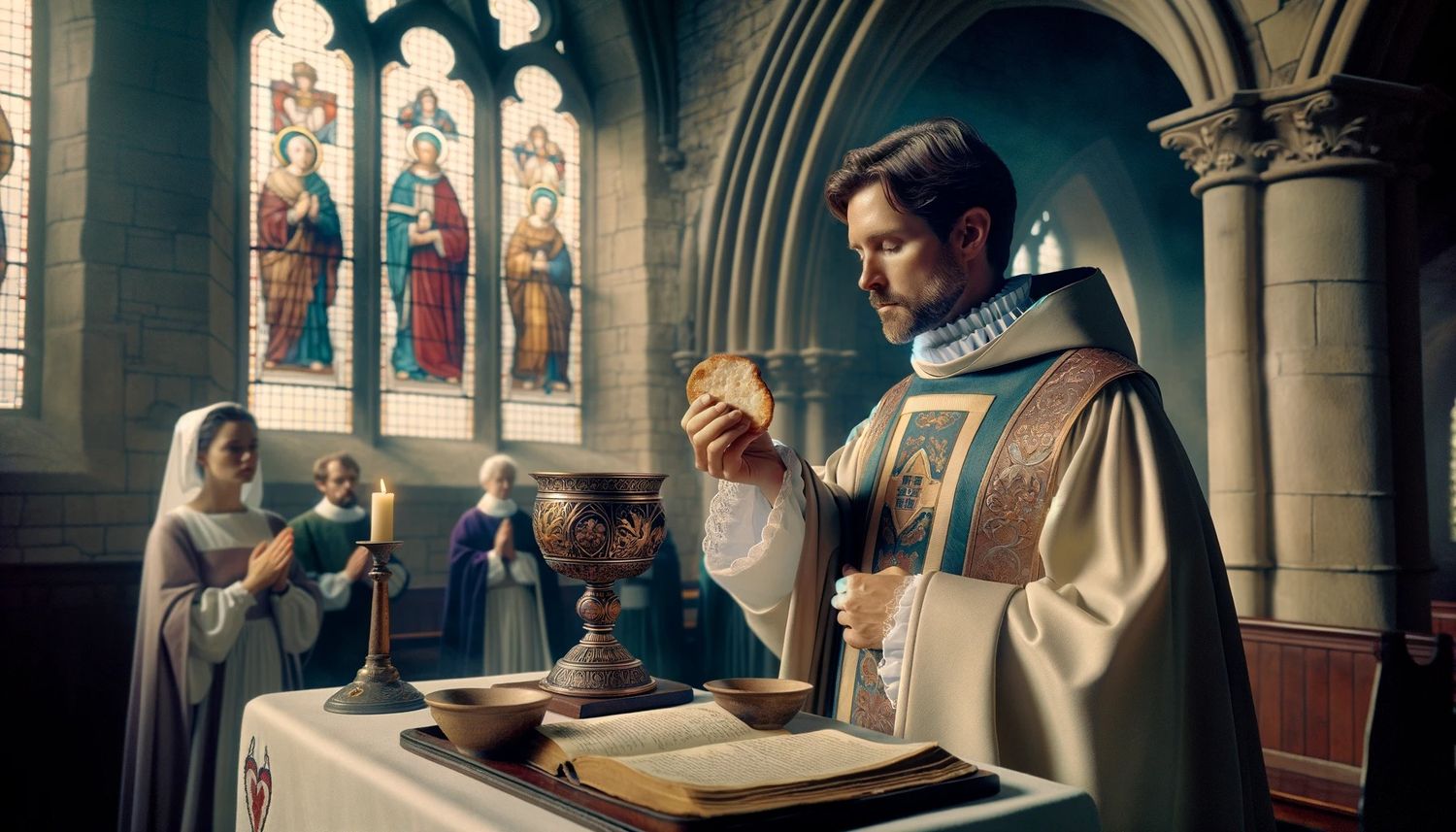Home>Theology and Spirituality>Why Do Some Churches Cover The Communion Elements


Theology and Spirituality
Why Do Some Churches Cover The Communion Elements
Published: February 25, 2024
Ericka Andersen, an editor at Christian.net, expertly merges digital strategy with content creation, focusing on faith and societal issues. Her communication skills enhance the platform's engaging narratives, fostering meaningful dialogue on belief's impact on society.
Discover the significance of covering communion elements in churches. Explore the theological and spiritual reasons behind this practice. Gain insights into the symbolism and traditions.
(Many of the links in this article redirect to a specific reviewed product. Your purchase of these products through affiliate links helps to generate commission for Christian.net, at no extra cost. Learn more)
Table of Contents
Introduction
The act of covering the communion elements, namely the bread and wine, during religious services has been a longstanding tradition in many Christian denominations. This practice holds deep historical, symbolic, and theological significance, and has sparked debates and controversies within the church community. Understanding the reasons behind this tradition and its implications is essential for gaining insight into the diverse perspectives within Christianity.
Covering the communion elements is a ritual that has been observed for centuries, with its roots intertwined in the rich tapestry of Christian history and tradition. The act of covering the bread and wine during the Eucharist or Holy Communion service is a solemn and reverent practice that carries profound spiritual meaning for many believers. It serves as a visual and symbolic representation of the sacred nature of the elements and the reverence with which they are regarded.
Throughout the centuries, the act of covering the communion elements has evolved and adapted within different Christian traditions, reflecting the diverse theological and cultural contexts in which it is practiced. This tradition has not only survived the test of time but has also become a focal point of theological discussions and interpretations within the Christian faith.
As we delve into the historical, symbolic, theological, and practical aspects of covering the communion elements, we will gain a deeper understanding of the multifaceted significance of this tradition. It is within this exploration that we will uncover the layers of meaning and significance that have contributed to the enduring practice of covering the communion elements in various Christian traditions.
Historical Background of Covering Communion Elements
The historical roots of covering the communion elements can be traced back to the early centuries of Christianity. In the early Christian church, the Eucharist, or Holy Communion, held profound significance as a central ritual of worship. The practice of covering the communion elements, specifically the bread and wine, during the Eucharistic celebration, emerged as a way to convey reverence and sanctity for these sacred symbols.
During the early centuries of Christianity, the church faced periods of persecution, and as a result, the Eucharistic elements were often concealed to protect them from desecration. This led to the development of the practice of covering the communion elements with a veil or cloth, symbolizing the need to safeguard the sacred elements from external threats.
As Christianity gained legal recognition and flourished, the act of covering the communion elements continued to be upheld as a symbol of reverence and respect for the body and blood of Christ. The covering of the elements became deeply ingrained in the liturgical traditions of the church, with specific rituals and prayers associated with the unveiling and covering of the bread and wine during the Eucharistic service.
The historical background of covering the communion elements also reflects the influence of cultural and regional variations within Christian traditions. Different denominations and geographic regions developed unique customs and practices related to the covering of the communion elements, further enriching the historical tapestry of this tradition.
Throughout the medieval period and into the Renaissance, the act of covering the communion elements remained a prominent feature of Christian liturgical practice. The symbolism of veiling and unveiling the elements during the Eucharistic celebration continued to hold deep spiritual significance, emphasizing the sacred nature of the bread and wine as the body and blood of Christ.
As the Protestant Reformation unfolded in the 16th century, various reformers and theologians reexamined the significance of covering the communion elements within the context of their theological perspectives. This historical backdrop laid the foundation for diverse interpretations and practices related to the covering of the communion elements within different branches of Protestantism.
In summary, the historical background of covering the communion elements is deeply intertwined with the early development of Christian liturgical practices, the challenges faced by the early church, and the evolving theological and cultural contexts of Christianity. This historical journey provides valuable insights into the enduring significance of covering the communion elements within the diverse tapestry of Christian traditions.
Symbolism and Meaning of Covering Communion Elements
The act of covering the communion elements during religious services carries profound symbolism and meaning within Christian traditions. The covering of the bread and wine, representing the body and blood of Christ, is laden with rich theological significance and symbolic depth.
-
Reverence and Sanctity: The covering of the communion elements symbolizes the reverence and sanctity with which the body and blood of Christ are regarded. By veiling the bread and wine, the church emphasizes the sacred nature of these elements and underscores the solemnity of the Eucharistic celebration.
-
Mystery and Transcendence: The act of covering the communion elements conveys the mysterious and transcendent nature of the Eucharist. The veil or cloth serves as a visual representation of the profound mystery of Christ's presence in the bread and wine, inviting believers to contemplate the divine mystery of the Eucharistic feast.
-
Protection and Shelter: Historically, the covering of the communion elements served as a means of protection, shielding the sacred symbols from desecration and external threats. This symbolism of protection and shelter reflects the church's commitment to safeguarding the sanctity of the Eucharistic elements.
-
Anticipation and Revelation: The act of unveiling the covered communion elements during the Eucharistic service symbolizes the anticipation and revelation of Christ's presence. As the veil is lifted, it signifies the unveiling of the divine mystery and the revelation of Christ's redemptive presence in the bread and wine.
-
Unity and Communion: In some Christian traditions, the act of covering the communion elements is associated with the theme of unity and communion within the body of Christ. The covering and unveiling of the elements underscore the communal aspect of the Eucharist, emphasizing the shared participation in the body and blood of Christ among believers.
-
Continuity and Tradition: The tradition of covering the communion elements also symbolizes the continuity of faith and tradition within the church. It serves as a link to the historical and liturgical practices of the early Christian church, connecting present-day believers to the enduring legacy of the Eucharistic celebration.
In essence, the symbolism and meaning of covering the communion elements encompass reverence, mystery, protection, anticipation, unity, and tradition, weaving together a tapestry of profound spiritual significance within the Christian faith. This symbolism continues to resonate deeply within the hearts and minds of believers, enriching the experience of the Eucharistic celebration and reinforcing the sacred nature of the communion elements.
Theological Perspectives on Covering Communion Elements
The theological perspectives on covering the communion elements encompass a spectrum of interpretations and theological frameworks within Christian traditions. These perspectives are deeply rooted in theological reflections on the Eucharist, the nature of the sacraments, and the symbolism of the bread and wine as the body and blood of Christ.
Sacramental Presence and Real Presence
Within Catholic and Orthodox theological perspectives, the act of covering the communion elements is intricately linked to the concept of sacramental presence and real presence. The veiling of the bread and wine underscores the belief in the real presence of Christ in the Eucharistic elements. The covering serves as a visual representation of the sacred mystery of Christ's presence, veiled yet profoundly real, inviting believers to contemplate the transcendent nature of the Eucharist.
Read more: Why Do Catholics Take Communion
Reverence and Transubstantiation
In Catholic theology, the act of covering the communion elements reflects the reverence and awe with which the Eucharistic elements are approached. The veiling of the bread and wine underscores the doctrine of transubstantiation, the belief that the substance of the bread and wine is transformed into the body and blood of Christ while retaining the outward appearance of bread and wine. The covering serves as a tangible expression of the profound transformation occurring during the Eucharistic celebration.
Memorial and Symbolic Presence
In Protestant theological perspectives, the act of covering the communion elements is often viewed through the lens of memorial and symbolic presence. The covering of the bread and wine serves as a symbolic gesture, emphasizing the memorial aspect of the Eucharist as a remembrance of Christ's sacrificial death. While the elements are not believed to undergo a literal transformation, the covering underscores the symbolic significance of the bread and wine as representations of Christ's body and blood.
Liturgical Symbolism and Reverent Gestures
Across various Christian traditions, the act of covering the communion elements is intertwined with liturgical symbolism and reverent gestures. The veiling and unveiling of the elements during the Eucharistic service are seen as profound acts of worship, reflecting the theological understanding of the Eucharist as a sacred and transformative encounter with the divine. The covering serves as a tangible expression of the theological convictions surrounding the Eucharistic celebration.
In summary, the theological perspectives on covering the communion elements reflect the diverse theological traditions and interpretations within Christianity, encompassing beliefs about sacramental presence, reverence, memorial, and liturgical symbolism. These perspectives contribute to the rich theological tapestry of the Eucharistic celebration, shaping the practices and beliefs of believers across different Christian denominations.
Practical Reasons for Covering Communion Elements
Beyond the historical, symbolic, and theological dimensions, there are practical reasons underlying the tradition of covering the communion elements within Christian worship. These practical considerations have contributed to the enduring practice of veiling the bread and wine during the Eucharistic celebration.
Preservation and Protection
One practical reason for covering the communion elements is the preservation and protection of the bread and wine. By veiling the elements, the church seeks to safeguard them from external elements such as dust, insects, or accidental contamination. This practice ensures that the bread and wine remain pure and uncontaminated, upholding the integrity of the Eucharistic symbols.
Aesthetic Presentation
The act of covering the communion elements also serves an aesthetic purpose within the context of liturgical worship. A carefully crafted veil or cloth adds to the visual solemnity and reverence of the Eucharistic celebration. It contributes to the overall aesthetic presentation of the altar and the sacred elements, enhancing the sense of sacredness and beauty associated with the Eucharistic ritual.
Practical Logistics
In some church settings, practical logistics play a role in the decision to cover the communion elements. For example, covering the bread and wine during the preparation and procession to the altar can help prevent spillage or mishandling. It ensures that the elements are securely and respectfully transported to the altar, minimizing the risk of accidents or disruptions during the Eucharistic procession.
Cultural and Regional Traditions
In certain cultural and regional contexts, practical considerations related to climate and environmental factors may influence the practice of covering the communion elements. For instance, in outdoor or open-air worship settings, covering the elements may protect them from exposure to wind, rain, or other environmental elements, ensuring their integrity and suitability for the Eucharistic celebration.
Read more: Why Do You Take Communion
Reverent Handling and Storage
Covering the communion elements also facilitates reverent handling and storage before and after the Eucharistic service. The veil or cloth serves as a tangible reminder of the sacred nature of the bread and wine, prompting careful and respectful handling by clergy and liturgical ministers. It also signifies the reverent storage of the consecrated elements following the Eucharistic celebration.
In essence, the practical reasons for covering the communion elements encompass preservation, aesthetics, logistics, cultural considerations, and reverent handling. These practical dimensions complement the historical, symbolic, and theological significance of the tradition, contributing to the holistic understanding of the practice of covering the communion elements within Christian worship.
Controversies and Debates Surrounding Covering Communion Elements
The tradition of covering the communion elements has not been without its share of controversies and debates within the Christian community. While this practice holds deep historical, symbolic, and theological significance for many believers, it has also sparked discussions and disagreements surrounding its relevance and interpretation.
One point of contention revolves around the theological implications of covering the communion elements. Within diverse Christian traditions, varying theological perspectives on the Eucharist and the nature of the sacraments have led to debates about the symbolism and necessity of veiling the bread and wine. These theological debates often intersect with broader discussions about the real presence, transubstantiation, memorialism, and the liturgical significance of the Eucharistic celebration.
Furthermore, controversies have arisen regarding the cultural and regional variations in the practice of covering the communion elements. Different Christian denominations and geographic regions have developed unique customs and traditions related to the veiling of the elements, leading to debates about the cultural relevance and adaptability of this practice in contemporary worship settings. These discussions often reflect the tension between preserving historical traditions and embracing cultural diversity within the church.
In addition, practical considerations have fueled debates about the necessity of covering the communion elements. Some individuals and communities question the practical relevance of this tradition in modern worship contexts, raising concerns about its aesthetic, logistical, and environmental implications. These practical debates intersect with broader conversations about the adaptability of liturgical practices to contemporary worship spaces and cultural contexts.
Moreover, controversies have emerged regarding the inclusivity and accessibility of the Eucharistic celebration in relation to the practice of covering the communion elements. Some individuals have raised concerns about the potential barriers created by veiling the bread and wine, particularly for individuals with visual impairments or those who may struggle to fully engage in the visual aspects of the Eucharistic ritual.
Overall, the controversies and debates surrounding covering the communion elements reflect the dynamic and multifaceted nature of Christian worship practices. These discussions encompass theological, cultural, practical, and accessibility considerations, highlighting the ongoing dialogue within the Christian community about the relevance and interpretation of this longstanding tradition.
Conclusion
The tradition of covering the communion elements during the Eucharistic celebration embodies a tapestry of historical, symbolic, theological, and practical significance within Christian worship. From its early roots in the early Christian church to its diverse interpretations within contemporary Christian traditions, the act of veiling the bread and wine has remained a focal point of reverence, mystery, and theological reflection.
The historical background of covering the communion elements reflects the challenges and triumphs of the early church, underscoring the enduring commitment to safeguarding the sanctity of the Eucharistic elements. This historical journey provides a compelling narrative of resilience and devotion, shaping the evolution of the tradition across different cultural and regional contexts.
Symbolically, the act of covering the communion elements weaves together themes of reverence, mystery, protection, anticipation, unity, and tradition, inviting believers to engage with the profound spiritual depth of the Eucharistic celebration. The veiling and unveiling of the elements serve as poignant reminders of the sacred mystery of Christ's presence and the communal participation in the body and blood of Christ.
The theological perspectives on covering the communion elements offer a glimpse into the diverse theological traditions within Christianity, encompassing beliefs about sacramental presence, reverence, memorialism, and liturgical symbolism. These perspectives contribute to the rich theological tapestry of the Eucharistic celebration, shaping the practices and beliefs of believers across different Christian denominations.
Furthermore, the practical reasons for covering the communion elements highlight the intersection of preservation, aesthetics, logistics, cultural considerations, and reverent handling, adding depth to the multifaceted nature of this tradition. These practical dimensions complement the historical, symbolic, and theological significance of the tradition, contributing to a holistic understanding of its role within Christian worship.
Amidst the controversies and debates surrounding covering the communion elements, the Christian community continues to engage in meaningful dialogue about the relevance and interpretation of this tradition. These discussions reflect the dynamic nature of worship practices and the ongoing quest to balance tradition with cultural diversity, accessibility, and practical considerations.
In conclusion, the tradition of covering the communion elements stands as a testament to the enduring legacy of the Eucharistic celebration, embodying centuries of faith, devotion, and theological reflection. As believers continue to gather around the Eucharistic table, the act of veiling the bread and wine serves as a poignant reminder of the sacred mystery and transformative power of Christ's presence in the midst of the worshipping community.












